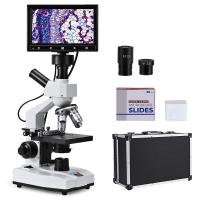What Is Magnification Microscope ?
Magnification in a microscope refers to the ability of the microscope to enlarge the size of an object being observed. It is a measure of how much larger the image of the object appears compared to its actual size. Magnification is achieved through the use of lenses in the microscope, which bend and focus light to create a magnified image. The total magnification of a microscope is determined by the combination of the magnifying power of the objective lens (located near the specimen) and the eyepiece lens (where the observer looks through). The magnification power of a microscope is typically indicated by a number followed by "X" (e.g., 10X, 40X, 100X), which represents how many times larger the image appears compared to the actual size of the object. Higher magnification allows for more detailed observation of small structures or features.
1、 Optical magnification in microscopy
Optical magnification in microscopy refers to the process of enlarging an image of a specimen using a microscope. It is a fundamental concept in microscopy that allows scientists and researchers to observe and study objects at a much larger scale than what is visible to the naked eye.
A magnification microscope works by utilizing a combination of lenses to increase the apparent size of the specimen. The primary lens, known as the objective lens, is responsible for capturing the light that passes through the specimen and forming a magnified image. This image is then further enlarged by the eyepiece lens, which is observed by the viewer.
The magnification power of a microscope is determined by the combination of the objective lens and the eyepiece lens. The objective lens typically has multiple magnification options, allowing users to switch between different levels of magnification. The eyepiece lens usually provides an additional magnification factor, further enhancing the overall magnification of the image.
In recent years, there have been advancements in microscopy technology that have expanded the capabilities of optical magnification. For example, the development of high-resolution objective lenses and digital imaging systems has allowed for more detailed and accurate observations. Additionally, techniques such as confocal microscopy and super-resolution microscopy have pushed the limits of optical magnification, enabling scientists to visualize structures at the nanoscale level.
Overall, optical magnification in microscopy plays a crucial role in scientific research, allowing scientists to explore and understand the intricate details of various specimens. It continues to evolve with advancements in technology, providing researchers with new tools and capabilities to further their investigations.

2、 Digital magnification in microscopy
Magnification in microscopy refers to the process of enlarging an object or specimen to make it visible to the human eye. It is a fundamental concept in microscopy that allows scientists and researchers to study and analyze microscopic structures and organisms in detail.
A magnification microscope is a type of microscope that utilizes lenses or a combination of lenses to magnify the image of an object. Traditional microscopes use optical lenses to magnify the specimen, while digital microscopes use digital imaging technology to achieve magnification.
Digital magnification in microscopy has gained popularity in recent years due to advancements in imaging technology. Digital microscopes capture images of the specimen using a digital camera and display them on a computer screen or other digital devices. The images can then be further magnified and analyzed using software tools. This allows for easy sharing, storage, and manipulation of the images, making it a convenient option for researchers and educators.
One of the latest advancements in digital magnification is the use of artificial intelligence (AI) algorithms. AI-powered microscopes can automatically identify and analyze specific features or structures within the specimen, providing valuable insights and speeding up the analysis process. This technology has the potential to revolutionize various fields, including medicine, biology, and materials science.
In conclusion, magnification in microscopy is essential for studying microscopic structures and organisms. Digital magnification, with its ability to capture, store, and analyze images, has become increasingly popular. The integration of AI algorithms further enhances the capabilities of digital microscopes, opening up new possibilities for scientific research and discovery.

3、 Total magnification in compound microscopes
Total magnification in compound microscopes refers to the overall level of enlargement achieved when viewing a specimen through the combined effects of the objective lens and the eyepiece. The magnification of a microscope is a crucial factor in determining the level of detail and clarity that can be observed.
A compound microscope typically consists of multiple lenses, including the objective lens located near the specimen and the eyepiece lens through which the observer views the image. The objective lens is responsible for the primary magnification, while the eyepiece lens further enlarges the image for the observer. The total magnification is calculated by multiplying the magnification of the objective lens by the magnification of the eyepiece.
For example, if the objective lens has a magnification of 40x and the eyepiece has a magnification of 10x, the total magnification would be 400x (40x multiplied by 10x). This means that the image observed through the microscope appears 400 times larger than the actual size of the specimen.
It is important to note that the total magnification is not the only factor that determines the quality of the image. Other factors, such as the numerical aperture of the lenses, the resolution of the microscope, and the quality of the specimen preparation, also play a significant role in the level of detail that can be observed.
In recent years, advancements in microscope technology have led to the development of high-resolution imaging techniques, such as confocal microscopy and super-resolution microscopy. These techniques allow for even greater magnification and improved resolution, enabling scientists to observe structures and processes at the nanoscale level.
In conclusion, total magnification in compound microscopes refers to the overall level of enlargement achieved through the combination of the objective lens and the eyepiece. It is an important factor in determining the level of detail that can be observed. However, it is essential to consider other factors that contribute to image quality, and advancements in microscopy technology continue to push the boundaries of magnification and resolution.

4、 Resolution and magnification in microscopy
Magnification in microscopy refers to the ability of a microscope to enlarge an object or specimen, allowing for a closer examination of its details. It is a measure of how much larger an object appears when viewed through the microscope compared to the naked eye. Magnification is achieved through the use of lenses that bend light and focus it onto the viewer's eye or a camera.
On the other hand, resolution in microscopy refers to the ability of a microscope to distinguish between two closely spaced objects as separate entities. It is a measure of the level of detail that can be observed in an image produced by the microscope. Resolution is determined by factors such as the wavelength of light used, the numerical aperture of the lens, and the quality of the optics.
The magnification of a microscope does not necessarily correlate with its resolution. While increasing magnification allows for a larger image of the specimen, it does not necessarily improve the level of detail that can be observed. In fact, increasing magnification without improving resolution can lead to a blurry or distorted image.
To achieve high-resolution microscopy, techniques such as confocal microscopy, super-resolution microscopy, and electron microscopy have been developed. These techniques utilize advanced optics, lasers, and electron beams to overcome the limitations of traditional light microscopy and achieve higher levels of resolution.
In recent years, there has been a growing focus on improving both magnification and resolution in microscopy. Advances in technology have led to the development of new microscopy techniques that offer higher magnification and resolution, allowing for more detailed and accurate observations. Additionally, the integration of computational imaging and artificial intelligence has further enhanced the capabilities of microscopy, enabling automated analysis and interpretation of microscopic images.
In conclusion, magnification in microscopy refers to the enlargement of an object, while resolution refers to the level of detail that can be observed. Both magnification and resolution are important factors in microscopy, and recent advancements in technology have led to significant improvements in both aspects.






























There are no comments for this blog.